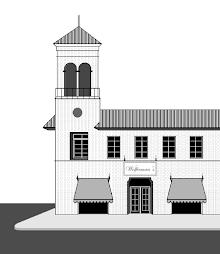Our next-to-the-last The History of the 5 & 10 section covers five retail chains simultaneously. All concerns -at one time or another- operated variety stores.
BUTLER BROTHERS - BEN FRANKLIN
Charles Hamblet Butler, George Henry Butler and Edward Burgess Butler formed Butler Brothers of Boston, a mail-order catalog enterprise, in 1877. A Chicago headquarters was established in 1880, with the Boston office being closed down. Early branch offices was established in New York City and Saint Louis.
By the turn of the 20th century, the Butler Brothers enterprise was one of the world's largest wholesale distributors of general merchandise. The company's first brick & mortar stores appeared in the late 1920s. A franchise system of locally-owned Ben Franklin variety stores was created in early 1927. These would be located in small towns across the nation and be operated in conjunction with branches of franchised Federated Stores, company-owned Butler Brothers department stores and Scott and L.C. Burr 5 & 10s.
All corporate operations had been consolidated into the Chicago headquarters by 1930. The company was now promoted as the House of Butler Brothers. By 1936, there were 2,600 Ben Franklin Stores, 1,400 Federated Stores and numerous Scott-Burr Stores. Butler Brothers department stores were starting to be phased out by the mid-1950s.
The T. G. & Y. chain of 127 5 & 10 stores was acquired by Butler Brothers in 1957. In February 1960, the Butler Brothers-Ben Franklin-T G & Y venture was sold to City Products Corporation, of Ohio. The Butler Brothers department stores division was slowly closed out, with the last stores going dark in 1974.
The new emphasis was on expansion of the Ben Franklin chain. In 1961, there were 2,400 franchised Ben Franklin stores. A discount mart division was in operation by the 1970s, with these large-format stores branded as either Ben Franklin Family Centers or B & C Family Centers. The latter included a supermarket.
The owner of the Ben Franklin franchise decided to open a line of corporate-owned and operated stores in the early 1990s. This endeavor proved unsuccessful and by 1997, the company was bankrupt. Racine, Wisconsin's Promotions Unlimited, another catalog concern, bought the Ben Franklin Stores name and began providing merchandise to the remaining Ben Franklin stores.
Promotions Unlimited entered bankruptcy proceedings in 2017. At this time, there were approximately 160 Ben Franklin stores in operation in the United States. These were geared toward arts & crafts-type merchandise.
BUTLER BROTHERS JUNIOR-ANCHORED SHOPPING MALLS:
*NORTHGATE CENTER, King County (Seattle), WA [1951]
*LAKEWOOD CENTER, Lakewood, CA [1951]
*STONESTOWN CENTER, San Francisco, CA [1952]
BEN FRANKLIN JUNIOR-ANCHORED SHOPPING MALLS:
*MOANALUA CENTER, Honolulu County, HI [1954]
*WINROCK CENTER, Albuquerque, NM [1973]
*WEST PARK PLAZA, Billings, MT [1986]
Chicago's Butler Brothers was predominantly a mail order and merchandise distribution company, but it did operate several different store chains across the nation. Butler Brothers units -such as the Lakewood, California store seen above- were traditional department stores.
Photo from https://lakewood-ca.smugmug.com / Dean Lester Photography
Butler Bros. trademarks from 1952 and 1954.
Graphics from House of Butler Brothers
Like Ben Franklin Stores (also a Butler Brothers endeavor) Federated Stores of America was a group of franchised 5 & 10s. Frankly, things must have been pretty confusing, Federated-wise. In addition to this chain, there was Federated Department Stores, a Cincinnati-based holding company. In addition to "carriage trade" department stores, they operated a line of stores known as Fedway. There was also another Dearborn, Michigan-based enterprise known as Federal Department Stores.
Graphic from House of Butler Brothers
Scott and L.C. Burr stores were also 5 & 10s. However, they were owned and operated by Butler Brothers.
Graphic from House of Butler Brothers
This Art Deco structure housed the Akron, Ohio Scott Store.
Drawing from Historic Postcards from Akron, Ohio
Eventually, the Scott and Burr's chains merged into one, as evidenced in this 1950 trademark.
Graphic from House of Butler Brothers








